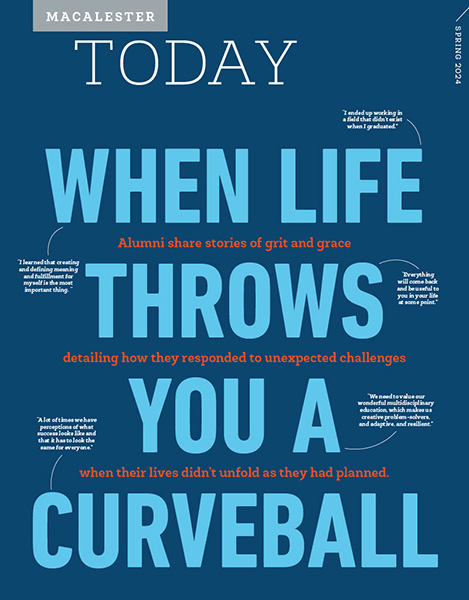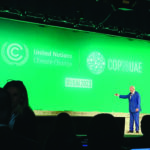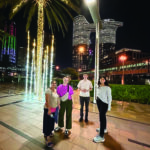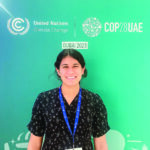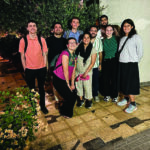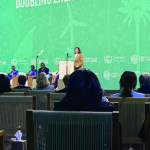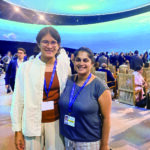
By Camellia Nai Schwartzman ’25 / Photos courtesy of Camellia Nai Schwartzman ’25
The Conference of the Parties to the United Nations Framework Convention on Climate Change is the largest climate-change conference in the world. The twenty-eighth conference, COP28, took place in Dubai in November. Physics major Camellia Nai Schwartzman ’25 (Galesburg, Ill.), along with eight other Macalester students, attended COP28. Here she shares details and photos from her firsthand experience.
It was part of the first-week delegation led by environmental studies professor Roopali Phadke. A second group of students, led by environmental studies professor Louisa Bradtmiller, attended the second week. Our place at COP28 was as conference observers, representing the public to monitor the accountability of the negotiations.
The first week had a lot of speeches made by heads of state and the second week was mostly negotiations. Each of us had a topic to focus on throughout our time at the COP. My topic was on sustainable cities and development, but I also have a personal interest in energy and just transitions (the transparent and equitable transition to clean energy while ensuring those most impacted have a say in the decision-making process) so I attended many events to look at both.
In terms of location and people, COP28 was the largest COP ever. It was held in Expo City, site of the Dubai Expo 2020. This also was the first year that lobbyists had to declare who they represented. Some 2,450 lobbyists attended, which was much larger than the top ten most vulnerable countries’ delegations combined.
The conference had two sides, the Blue Zone and the Green Zone. The Blue Zone, where negotiations took place, had limited access. The Green Zone was open to the public and had a lot of booths with start-ups, and museum-like attractions. This year, the number of Blue Zone attendees nearly doubled compared to the previous record set last year at COP27 in Egypt.
Our badges gave us access to the Blue Zone. I was lucky enough to get a ticket to see a talk on energy and just transition given by heads of state including presidents and special envoys representing countries across the world.
There, I saw the makings of history and breaking news. It is hard to describe what it felt like to hear the speeches in person and see the headlines of the New York Times containing pieces of that very same speech. I saw the COP president give the speech on the global pledge to double energy efficiency and triple renewable energy capacity by 2050 with 218 signatories.
Language use was critically important at COP. Knowing the difference between phase-out or phase-down of fossil fuels, whether it means to truly get rid of fossil fuels or get rid of a few slowly, truly made all of the difference in understanding the full meaning behind the words.
One of the best speeches that I heard was by former vice president Al Gore and Gavin McCormick, co-founder of Climate TRACE (ClimateTrace.org). The website takes images of landfills, power plants, and other means of CO2 production and combines it with satellite imaging, estimating how much CO2 is produced more accurately than ever before, and in places all around the world. Gore and McCormick talked about the latest climate-change trends and data while also showing the newest updates to the website.
When I wasn’t in these high-level events, I listened to presentations by countries and NGOs that had side events on sustainable cities and energy. I heard city leaders discuss what they are doing to improve their cities, from increasing access to natural parks to promoting public transportation and better building weatherization.
The COP experience showed me how difficult it is to get all countries to agree on the same policy. The implementation of these policies is even more difficult. I can understand why there are so many people losing confidence with the process. At COP, it was impossible not to run into people who had lost hope for reaching 1.5 Celsius or, on the other hand, were trying to promote false solutions like carbon capture and storage (CCS) or increasing nuclear power capacity. I consider these false solutions because they have so many other associated problems. I believe we should be putting our resources behind other opportunities that could really help us reach the targets outlined in the Paris Agreement.
Even though the outcomes of this and other COP conferences have not changed policies at the scale that we need, it was incredible to see the number of people representing almost every country and Indigenous nation in the world working towards policies to avoid the worst effects of climate change.
May 17 2024
Back to top